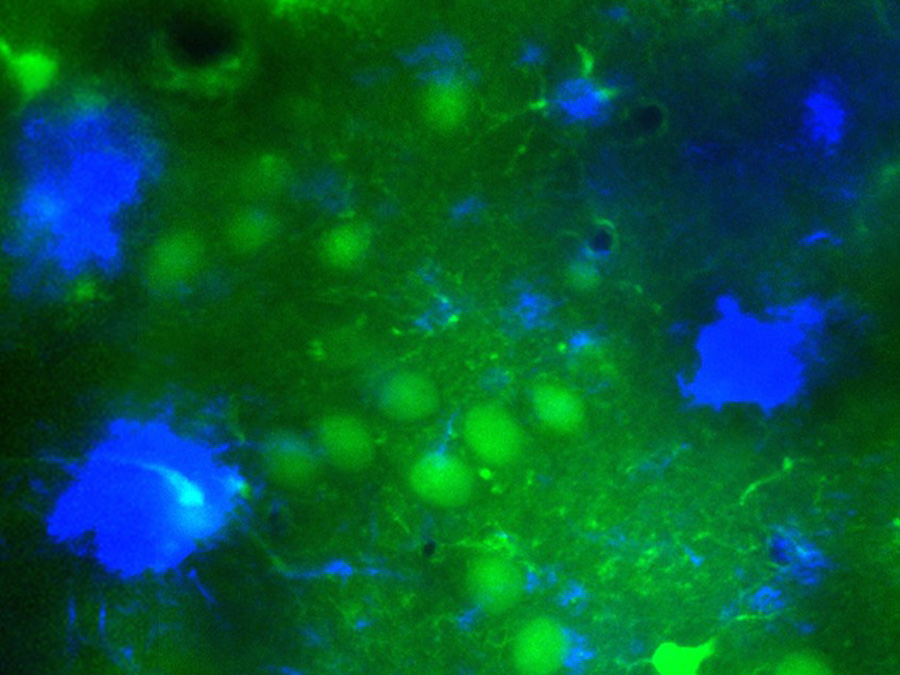Long overlooked eta-amyloid peptide plays a role in Alzheimer's disease
Dementia: Researchers have identified a new poisonous protein

The researchers refer to the newly characterized protein fragment by the Greek letter eta, christening it amyloid-η. "The processing pathway that produces it has been overlooked for 30 years," says Christian Haass, Professor of Metabolic Biochemistry at LMU and last author of the study. "This is because investigators including myself have focused their attention on elucidating the origins of the beta-amyloid and on attempts to cure Alzheimer’s by inhibiting production of this peptide." The paper that describes the generation of amyloid-η appears in the new issue of the journal Nature.
A previously unknown interaction
Two TUM researchers – Prof. Arthur Konnerth, Friedrich Schiedel Chair for Neuroscience, and Dr. Dr. Marc Aurel Busche of the Clinic and Polyclinic for Psychiatry and Psychotherapy at the TUM hospital Klinikum rechts der Isar – took part in the study within the framework of the Excellence Cluster SyNergy (Munich Cluster for Systems Neurology). Busche explains, "In recent years we have developed microscopic techniques that enabled us to analyze the effects of the newly identified eta-amyloid on the function of individual nerve cells in vivo – that is, in the intact brain. In prior experiments using this approach, we had already found out that the long recognized beta-amyloid leads to an abnormal increase in brain activity."
Together the researchers were able to determine the function of eta-amyloid in the brain: While accumulation of beta-amyloid creates chaos by making nerve cells hyperactive, eta-amyloid puts the brakes on this neuronal stimulation. "So here we have two small peptides, snipped from the same precursor protein, which have opposite effects on neuronal activity and whose actions must normally be carefully balanced," Haass says.
These findings have immediate implications for ongoing clinical trials in humans, all of which are targeted to beta-amyloid. One of the trials, for instance, is designed to ascertain whether or not pharmacological inhibition of beta-secretase, the proteolytic enzyme that initiates the release of the toxic beta-amyloid, can reduce memory loss in patients with Alzheimer’s disease.
Haass, first author Dr. Michael Willem (LMU), and their collaborators have now confirmed that blocking the action of the beta-secretase does indeed reduce levels of beta-amyloid. However, this is accompanied by a massive increase in the amount of eta-amyloid generated. "This could result in attenuation of neuronal activity and might therefore compromise brain function," says Haass. He therefore suggests that investigators need to be on the look-out for any signs of unanticipated side-effects in the current clinical trials.
Publication:
M. Willem, S. Tahirovic, M. A. Busche, S. V. Ovsepian, M. Chafai, S. Kootar, D. Hornburg, L. D.B. Evans, S. Moore, A. Daria, H. Hampel, V. Müller, C. Giudici, B. Nuscher, A. Wenninger-Weinzierl, E. Kremmer, M. T. Heneka, D. R. Thal, V. Giedraitis, L. Lannfelt, U. Müller, F. J. Livesey, F. Meissner, J. Herms, A. Konnerth, H. Marie & C. Haass, η-Secretase processing of APP inhibits neuronal activity in the hippocampus, Nature, August 2015.
DOI: 10.1038/nature14864
Contact:
Dr. Dr. Marc Aurel Busche
Clinic and Polyclinic for Psychiatry and Psychotherapy
TUM Institute for Neurosciences
Tel: +49 (0)89 / 4140 - 4201
aurel.busche@lrz.tu-muenchen.de
Prof. Christian Haass
Chair of Metabolic Biochemistry, LMU
Tel: +49 (0)89 / 4400 - 46549
christian.haass@mail03.med.uni-muenchen.de
Dr. Michael Willem
Haass Lab
Tel: +49 (0)89 / 4400 - 46533
michael.willem@mail03.med.uni-muenchen.de
Technical University of Munich
Corporate Communications Center
- Nicola Holzapfel (LMU) / Dr. Vera Siegler (TUM)
- vera.siegler@tum.de
- presse@tum.de
- Teamwebsite